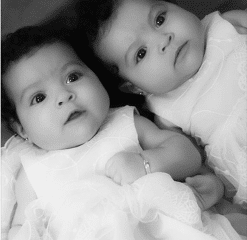Written By: Kalli Atti, PT, DPT; Edited By: Megan Castles, PT, DPT, ATC

What are potential causes & risk factors for Torticollis?

Torticollis is a very common diagnosis and how a baby develops Torticollis can vary! Here are some of the most common reasons:
- Most babies develop a type of Torticollis known as Congenital Torticollis from being confined in the womb. They wiggle themselves into a position and as a result of uterine restriction, these babies stay in these prolonged positions until delivery. Prolonged positioning in utero may also result in facial abnormalities, ear shifts, indents and flattening on their head.
- As you can imagine, twins share the space in their mommy’s bellies so twins are at a higher risk for developing Torticollis.
- Premature babies are also at a higher risk for developing Torticollis due to their soft heads and prolonged time in one position in the NICU. This is called Positional or Acquired Torticollis.
- There are many different orthopedic, genetic and neurological conditions that may result in Torticollis. Some of these include: brachial plexus injuries, stroke, hemiplegia, facial paralysis, fractures, Klippel Feil Syndrome, and hydrocephalus. Babies with hydrocephalus will tend to tilt towards the shunt and rotate away from the shunt. Babies with brachial plexus injuries, stroke, and hemiplegia also tend to rotate their head away from the affected area. It resembles a neglect of the affected side.
- Weakness of one eye compared to the other can also result in Torticollis known as Oculotorticollis. When one eye is stronger than the other, most commonly a strabismus or a nystagmus, then the child puts his/her head at a tilt to prevent double vision or blurring. Our babies are very smart and they make the adjustments they need to help themselves. It is up to medical professionals to help figure out what is causing their head tilt and rule in/out possible visual components! A nystagmus is when an eye(s) quickly and rhythmically jerks back and forth. A strabismus is a visual impairment where the eyes are not aligned when looking at an object, like being cross eyed or if you’ve heard of someone having a “lazy eye.”
- Other babies develop Torticollis because of esophageal reflux! Most babies with reflux will arch their backs but sometimes, in order to get away from the pain, babies will choose a side and tilt to the left or right. If your baby is very fussy, crying in pain, or having trouble relaxing after a feeding, it is possible they may have reflux. Some babies with reflux may not ever spit up! These babies may have something known as “silent reflux.” The connection between the stomach and the esophagus does not close properly and the acids come back up resulting in pain. Typical reflux babies will often spit up even hours after a feeding, but silent reflux babies may show symptoms of gas bubbles, choking, and coughing. Babies with any kind of reflux frequently develop stronger extension patterns which make for difficulty sitting up and learning how to crawl on hands and knees. If Torticollis is a result of reflux, these babies usually show progression quickly with reflux medication. You would need to see your Gastroenterologist for diagnosis. Do keep in mind that a baby placed on reflux medication may see results quickly but if you switch medications frequently or are weaning off of a reflux medication, the medication may stay in your baby’s system up to 3 weeks. You may think your baby is doing fine without the medication and after 2-3 weeks of being off the medication, the baby starts to show reflux signs and symptoms again. Most of the time, reflux will start to resolve around 6 months and fully resolve around 12 months. However, if you think of all this time a baby is growing and learning developmental milestones, this is a lengthy time for babies to develop muscle imbalances and postural compensations if not taken care of early on.


0 Comments